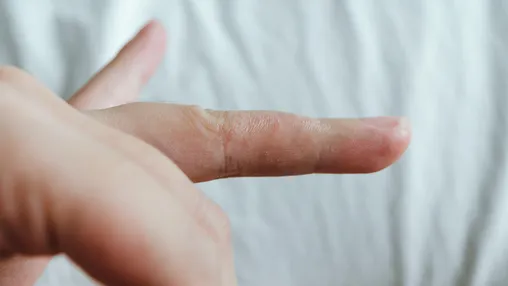Eczema Blisters: How to Help Prevent and Treat Them

When you have eczema, red, inflamed patches of skin that itch intensely are common. But you might also sometimes have to contend with another type of outbreak — eczema blisters, which can cause additional discomfort.
While blisters may be common with eczema, blisters do not automatically indicate that you have the skin condition. Eczema blisters form after an allergic reaction, in response to an environmental irritant, or from an infection.
Types of Eczema Commonly Associated With Blisters
Blisters occur in response to inflamed or damaged skin, explains Peter Lio, MD, a dermatologist at Northwestern Memorial Hospital in Chicago. They are essentially skin bubbles filled with fluid.
“This fluid, referred to as serous fluid, is ultimately a blood filtration product and is similar to when there is swelling in an area such as a swollen ankle after a sprain,” he says. “In the skin, the fluid can be very concentrated around blood vessels and can be superficial enough to cause tiny blisters rather than just swelling of an area.”
Once an eczema blister forms, it takes time for the body to reabsorb this fluid, which usually happens through the lymphatic system, Dr. Lio says. “Sometimes, however, they are very tense and superficial and simply rupture, releasing the fluid outside of the skin and then needing [time] to heal,” he says.
Eczema blisters are associated with multiple types of eczema, and they can show up differently depending on the cause.
Dyshidrotic Eczema
“We often use soaks such as Burow’s solution to help soothe and dry out the blisters, and then have the patients apply the topical corticosteroid twice daily to the area,” he adds.
Allergic Contact Dermatitis
Irritant Contact Dermatitis
When Infections Cause Eczema Blisters
People with eczema are more prone to infections because burst blisters or damaged, raw skin can be a breeding ground for bacteria, fungi, or viruses, says Amy Kassouf, MD, a dermatologist with the Cleveland Clinic in Twinsburg, Ohio.
Signs an eczema blister has become infected include “red color, warmth to the touch, whitish liquid drainage, and swelling,” Dr. Rieder says.
Furthermore, “if the blister is large or painful or spreading, or you see redness and swelling underneath that is spreading, and certainly if you get a fever, you should be seen promptly by your doctor,” says Dr. Kassouf.
How to Help Prevent Eczema Blisters From Popping Up
The Takeaway
- There are many different types of eczema — including dyshidrotic eczema, allergic contact dermatitis, and irritant contact dermatitis — all of which can cause the skin to become swollen, irritated, itchy, and prone to developing blisters.
- Eczema blisters can’t always be avoided, but it’s important to stick to your treatment routine, keep your skin moisturized, and try not to scratch them.
- If you have worsening blisters or signs of infection (skin is red, warm to the touch, draining liquid, or swelling), visit your healthcare provider for treatment.
Additional reporting by Regina Boyle Wheeler.
Common Questions & Answers
- What Is Eczema? National Eczema Association. January 27, 2025.
- Dyshidrotic Eczema. National Eczema Association. February 20, 2025.
- Pompholyx (Dyshidrotic) Eczema. National Eczema Society.
- Eczema Types: Dyshidrotic Eczema Diagnosis and Treatment. American Academy of Dermatology Association. November 16, 2020.
- Poison Ivy, Poison Oak and Poison Sumac. Cleveland Clinic. May 5, 2023.
- Contact Dermatitis. National Eczema Association. January 27, 2025.
- de Groot AC. Fragrances: Contact Allergy and Other Adverse Effects. Dermatitis. January/February 2020.
- Dermatitis. University of Michigan Health-Sparrow. April 29, 2025.
- Contact Dermatitis. Cleveland Clinic. March 30, 2023.
- Contact Dermatitis. Mayo Clinic. May 2, 2024.
- Dry Skin Relief From Handwashing. American Academy of Dermatology Association. December 18, 2024.
- Xiao A et al. Health Conditions Related to Eczema. StatPearls. August 12, 2024.
- Eczema Herpeticum. American Osteopathic College of Dermatology.
- Staph Infections. Mayo Clinic. May 25, 2022.
- Dermatitis. Cleveland Clinic. October 29, 2020.

Jacquelyn Dosal, MD
Medical Reviewer
Jacquelyn Dosal, MD, is a board-certified dermatologist at Skin Associates of South Florida in Coral Gables. She practices general, medical, cosmetic, and surgical dermatology.
Dr. Dosal provides compassionate care to all her patients, listening to their concerns and creating a treatment plan with each patient's priorities and real life in mind.
She is a member of the voluntary faculty at the University of Miami.

Ashley Welch
Author
Ashley Welch has more than a decade of experience in both breaking news and long-form storytelling. She is passionate about getting to the crux of the latest scientific studies and sharing important information in an easy-to-digest way to better inform decision-making. She has written about health, science, and wellness for a variety of outlets, including Scientific American Mind, Healthline, New York Family, Oprah.com, and WebMD.
She served as the health editor for CBSNews.com for several years as a reporter, writer, and editor of daily health news articles and features. As a former staff member at Everyday Health, she covered a wide range of chronic conditions and diseases.
Welch holds a bachelor's degree from Fordham University and a master's degree from the Craig Newmark Graduate School of Journalism at the City University of New York, where she studied health and science reporting. She enjoys yoga and is an aspiring runner.